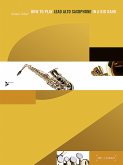A tone series, heard at the beginning in unison, is the basic material to be formed in the first movement. The intervals of a minor third and a fourth or fifth play a special role, whether in the melody or in the building of chords. Sharp differences in dynamics and articulation are features of of this first part of the work with its debt to the classical sonata form.The Sostenuto - returning repeatedly to the harmonic and hymn-like gestures of a funeral march - is subdivided by recitative-like insertions and spinning out of motifs and fading away in the "abgesang" in an chorale-like episode - a allusion to Bruckner.The persistent mixture of two overlapping ninths imposes itself on the vertical aspect of the burlesque third movement. On the horizontal plane, the intervals of the minor third and the fourth dominate - almost a return of material from the first movement. The formal structure is A B A, whereby B appears in the tempo of a Ländler.The fourth movement begins with an arioso introduction, followed by an Allegro vivace with rondo character. Driving rhythms, melodic ideas reminiscent of jazz as well as strong rhythmical contrasts determine its profile. With a slight air of resignation, the turbulent finale dies away. The work was composed in 1990 at the suggestion of Normand DesChênes.Instrumentation:4 saxophones (SATBar)op. 88fEine Tonfolge, die zu Beginn im Unisono vorgetragen wird, bildet das Ausgangsmaterial des 1. Satzes. Eine besondere Rolle spielen die Intervalle kleine Terz und Quarte bzw. Quinte, sowohl in der Melodie als auch bei der Akkordbildung. Starke Differenzierungen in Dynamik und Artikulation kennzeichnen diesen der klassischen Sonatenform verpflichteten ersten Teil des Werkes.Das Sostenuto - immer wieder zur harmonisch-hymnischen Geste eines Trauermarsches zurückkehrend - ist gegliedert durch rezitativische Einschübe und motivische Fortspinnungen und findet im Abgesang zu einer verklingenden choralartigen Episode - einer Bruckner-Allusion.Die festgehaltene Mixtur zweier in sich verschränkter Nonen bestimmt vertikal den burlesken 3. Satz. Horizontal ist die Intervallfolge kleine Terz und Quarte vorherrschend - quasi eine Wiederaufnahme des Tonmaterials aus dem 1. Satz. Die formale Gliederung ist A B A, wobei B im Tempo eines Ländlers erscheint.Der 4. Satz beginnt mit einer ariosen Einleitung, gefolgt von einem Allegro vivace mit Rondocharakter. Pochende Rhythmen, an den Jazz erinnernde Melodiefloskeln sowie starke dynamische Gegensätze geben ihm sein Gepräge. Wie mit einem Hauch von Resignation verlöschend endet das turbulente Finale. Das Werk entand im Jahre 1990 auf Anregung von Normand DesChênes.Schwierigkeitsgrad: 4-5
Hinweis: Dieser Artikel kann nur an eine deutsche Lieferadresse ausgeliefert werden.
Hinweis: Dieser Artikel kann nur an eine deutsche Lieferadresse ausgeliefert werden.








